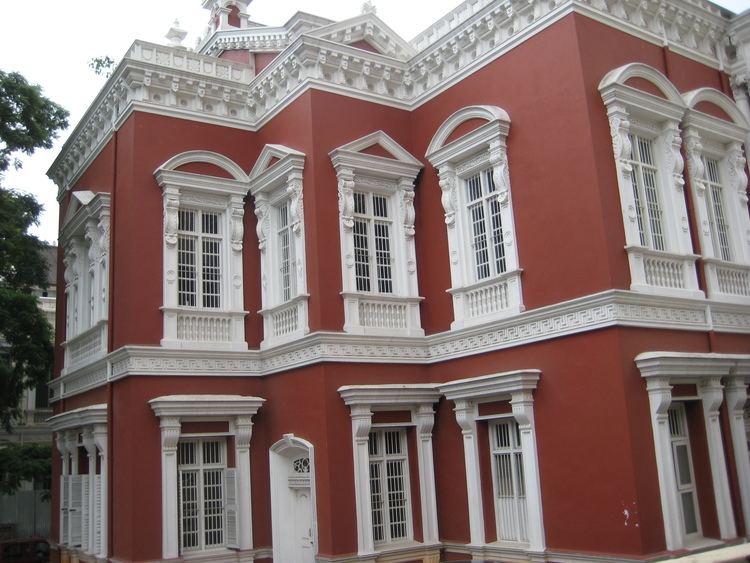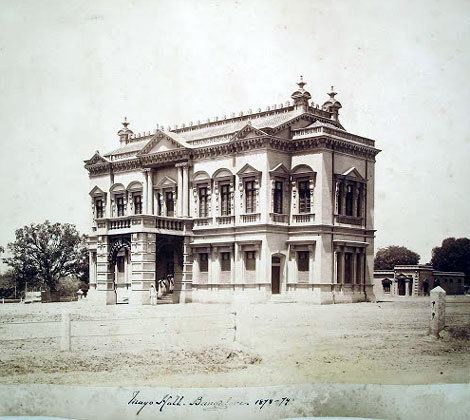 | ||
Mayo Hall is a stone and mortar structure built in the heart of the city of Bangalore, India. The towering hall is situated next to the Public Utility Building on Mahatma Gandhi Road, and offers a panoramic view of the cities' Parade grounds and Ulsoor Lake on one side, and the Bangalore Race Course and Brigade Grounds in the south.
The hall is lavishly decorated, with Italian chandeliers, ornate furniture, key stoned arches, Greek cornices, Tuscan columns and wooden floors all showing the influence of classical Greek and Roman architecture. Mayo Hall is now home to numerous departments of Bangalore Mahanagara Palike, Bangalore's administrative body, and was used until recently to try traffic crimes and register marriages.

The government's Kempegowda Museum is located on the first floor of Mayo Hall. It was established in the year 2011, and is dedicated to Kempegowda, the founder of Bangalore.The museum has Kempegowda's statue as well as artistic renderings from his time.

When originally built, the ground floor had the Municipal Office for the Cantonment, several public offices and law courts. The upper floor was designed for important 'Public meetings and Exhibitions'.

Going back to its very beginning, Mayo Hall became a part of a larger design to develop the cantonment into an integrated Bangalore Civil & Military station. Accordingly, around the mid-1800s, a series of developmental activity began.

The army that defeated Tipu Sultan in the 4th Mysore War was relocated from the swamps of Srirangapatana to the more temperate Bangalore. It was 1809 and the new garrison town began to grow. The crown's administrative staff and the army's families began arriving in droves, taking the arduous sailing route around the Cape of Good Hope. Sensing the business opportunities, tradesmen also traveled in this manner. Soon items never before seen in Bangalore started arriving, for it was a century of dramatic happenings. The world saw many firsts: postage stamps, automobiles, electric light bulbs, motion pictures, phonographs, photography, repetition rifles, railroad locomotives, steamships, telegraphs and telephones.

With this revolution began the 'westernisation' of Bangalore. "Roads, parks, promenades, churches, schools, hospitals, shopping centres, dance halls, pubs, clubs, cricket, golf range, and a race course came up where there were none," says Major-General (retd.) John Verghese. "Everything in Britain was brought here. Well, almost everything. Houses with fountains, tennis courts, and gardens came up in areas such as Richmond Town, South Parade, and St John's Church Road. Even flowers - phlox, zinnias, dahlias, and so on - and veggies such as cauliflower, cabbage, carrots and beetroot were brought from good ol' Blighty!"
In this period of rapid change, Lord Mayo (christened Richard Southwell Bourke) was appointed the Viceroy and Governor General of India, who hastened the development process. In the short period from 1869-72 when he was in India, this Trinity College, Dublin graduate travelled extensively, was greatly impressed with the people and the land, and said that Britain should hold India "as long as the sun shines in heaven". This sentiment was widely and enthusiastically shared in the Empire.
However, on a visit to Port Blair's prison, Lord Mayo's life was cut short. He was assassinated, stabbed to death by Sher Ali, a Pathan life convict, the only Indian Viceroy to be murdered in office. His murder was an act of revenge. The convict who killed him did so to avenge his father's death in the Anglo-Afghan War.
As a tribute to this administrator a commemorative building was erected on South Parade, on a flat ground with trees, flowering bushes and a low wall on the south side. Terraced lawns surrounded the two-story building. It cost about Rs 45,000, a sum largely raised through public subscription.
The Mayo Hall was inaugurated by the British Resident on June 6, 1883 - with considerable pomp and pageantry. As per the Bangalore District Gazetteer, "The building in elevation is remarkable for its composition of architravated and pedimented windows, varied with key-storied arches, beautifully executed consoles, balustraded ledges and typical Greek cornice."
Inside the building had a number of exquisitely framed pictures of the British nobility and outstanding citizens in the hall. In the first floor there were Italian chandeliers, ornate furniture and exquisite furnishings. Being on a hill, Mayo Hall offered a panoramic view of the Parade grounds and Ulsoor Lake on the one side and the Shoolay Lake, Race Course and Brigade Grounds in the south.
The late Kora Chandy described the Mayo Hall as 'one of the most elegant public buildings of the era in Southern India.' Several Greco-Roman elements and influences are apparent in the building: architrave and pediment windows, key-stoned arches, balustrade ledges, beautiful consoles, Greek cornices, Tuscan columns, and wooden floors.
Today Mayo Hall stands shorn of its greenery and breathing space. Tall buildings such as the Public Utility building and the Central Mall are its neighbours. Nearby heavy traffic generates significant sound pollution. The future of this historical building remains uncertain.
There is an apprehension that many of Bangalore's landmarks may, as is typical of old buildings, fall into disrepair or neglect in the future. This may be prevented, however, by an increase in communal pride and interest in history and heritage.
Many philanthropists and the local government are collaborating to support efforts that preserve and promote heritage and culture.
Mayo Hall is a case in point in history-rich Bangalore that deserves such support.
